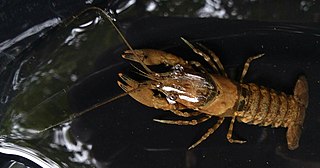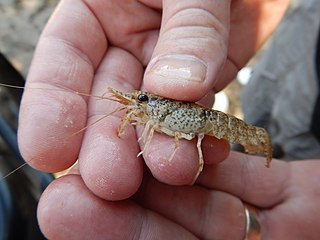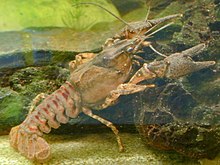
Cambarus is a large and diverse genus of crayfish from the United States and Canada. The adults range in size from about 5 cm (2.0 in) up to approximately 15 cm (5.9 in).

The Cambaridae are the largest of the four families of freshwater crayfish, with over 400 species. Most of the species in the family are native to the United States east of the Great Divide and Mexico, but fewer range north to Canada, and south to Guatemala and Honduras. Three live on the island of Cuba. The species in the genus Cambaroides are only found outside North America, as they are restricted to eastern Asia.

Cambarellus is a genus of small freshwater crayfish in the family Cambaridae. The 19 species are found in Mexico and the Gulf States of the United States. Among the Mexican species, C. areolatus, C. patzcuarensis, and C. prolixus are considered seriously threatened by the IUCN, and C. alvarezi is already extinct. C. chihuahuae was also believed to be extinct until rediscovered in 2012. C. alvarezi and four undescribed, extinct Cambarellus species were restricted to desert spring systems in southwestern Nuevo León; each one shared its habitat with a Cyprinodon pupfish.
Faxonius cooperi, the Flint River crayfish, is a species of crayfish in the family Cambaridae. It is endemic to Alabama and Tennessee in the United States. The common name refers to the Flint River, where the original specimens were found.
Faxonius saxatilis is a species of crayfish in the family Cambaridae. It is endemic to tributaries of the Kiamichi River, Le Flore County, Oklahoma. Its common name is Kiamichi crayfish.

Procambarus is a genus of crayfish in the family Cambaridae, all native to North and Central America. It includes a number of troglobitic species, and the marbled crayfish (marmorkrebs), which is parthenogenetic. Originally described as a subgenus for four species, it now contains around 161 species.

Walter Faxon was an American ornithologist and carcinologist. He was born at Jamaica Plain, Massachusetts, where he grew up. He received three degrees from Harvard University. One of his greater ornithological achievements was demonstration that Brewster's warbler is a hybrid.

Faxonius limosus, synonym Orconectes limosus, is a species of crayfish in the family Cambaridae. It is native to the east coast of North America, from Quebec to the lower James River, Virginia, but has also been introduced to Europe. It is known commonly as the spinycheek crayfish or Kamberkrebs in German.

Fallicambarus is a genus of crayfish in the family Cambaridae from the United States and Canada. It includes 12 species, of which one is on the IUCN Red List as a vulnerable species (VU) and one as an endangered species (EN). The species of this genus are all restricted to three states or fewer, from Texas and Oklahoma east to Florida.

Faxonius virilis is a species of crayfish known as the virile crayfish, northern crayfish,eastern crayfish, and lesser known as the lake crayfish or common crawfish. Faxonius virilis was reclassified in August 2017, and the genus was changed from Orconectes to Faxonius. It is native to the central United States, east to tributaries of Lake Erie, Lake Ontario, Lake Champlain and the St. Lawrence River in New York and to much of Canada.
Barbicambarus is a genus of freshwater crayfish found in Tennessee and Kentucky in the United States. It comprises two species:
Faxonius alabamensis, the Alabama crayfish, is a species of freshwater crayfish that lives in Alabama, Mississippi and Tennessee.

Procambarus fallax is a species of crayfish in the genus Procambarus. It lives in tributaries of the Satilla River in Georgia and Florida. It is the closest relative to the parthenogenetic marbled crayfish, Procambarus virginalis.

Faxonius maletae, sometimes called the Kisatchie painted crayfish or Kisatchie painted crawfish, is a species of crawdad in the Cambaridae family. The specific epithet maletae is in honor of the discoverer's wife, author Maleta M. Walls, who helped collect many of the original specimens. It was originally described as a subspecies of Orconectes difficilis, but later elevated to full species status. The common name refers to the Kisatchie National Forest, near where the original specimens were found in Bayou Santabarb.

Faxonius erichsonianus is a species in the family Cambaridae ("crayfishes"), in the order Decapoda. A common name for Faxonius erichsonianus is reticulate crayfish. Faxonius erichsonianus is found in the south eastern United States of America.

Faxonius validus, the powerful crayfish, is a species of crayfish in the family Cambaridae. It is found in North America.
Faxonella creaseri is a species of crayfish, a decapod crustacean in the family Cambaridae. It is one of the four species in the genus Faxonella.

Lacunicambarus is a genus of burrowing crayfishes in the family Cambaridae. There are currently 12 described species in Lacunicambarus, all of which are found east of the Continental Divide in North America. The genus was first recognized in 2018 when it was discovered through genetic analyses that the Cambarus subgenera Lacunicambarus and Tubericambarus were not monophyletic on their own, but that when combined they formed a single monophyletic group distinct from Cambarus. A 2022 study used anchored hybrid enrichment to resolve the Lacunicambarus phylogeny, which elucidated interspecific relationships and highlighted remaining undescribed diversity within the genus.

Faxonius lancifer, the shrimp crayfish, is a species of crayfish in the family Cambaridae. It is widespread in the South-Eastern United States.

Faxonius neglectus, a species of freshwater crayfish also known as the ringed crayfish, is native to Central North America, with two major disjunct areas of distribution in the Ozarks and around Nebraska. The species name, Faxonius neglectus, was previously Orconectes neglectus. Faxonius was declared its own genus in 2017 by Crandall & De Grave, as many previously thought Orconectes species were found to not reside in caves.















